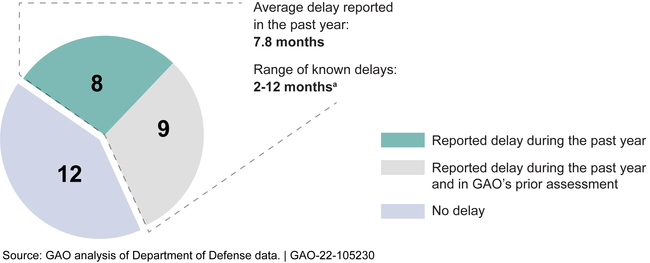Weapon Systems Annual Assessment: Challenges to Fielding Capabilities Faster Persist
Fast Facts
Our 20th annual assessment of DOD's weapons acquisitions (which are on our High Risk List) found that DOD is working to improve how fast it develops and delivers weapon systems.
But many weapon programs continue to face delays—partly because DOD didn't have the right information at key decision points about the weapon system's technology, design, or production.
We also recommended that DOD clarify when programs should assess risks to the defense industrial base (the companies that develop and manufacture weapon systems). For instance, some parts are made by a single supplier and could become unavailable if that supplier goes out of business.
The USS Gerald R. Ford Nuclear Aircraft Carrier Conducting Sea Trials

Highlights
What GAO Found
For over 20 years, GAO has assessed the Department of Defense's (DOD) weapon programs and noted significant changes in its acquisition policies and practices. GAO's first assessment in 2003 highlighted challenges, such as committing billions of taxpayer dollars before obtaining key information, including reliable cost estimates and proven designs. Yet these challenges still hinder many programs. And they slow the department's current emphasis on delivering capabilities to the warfighter faster.
This year's report analyzed 63 of DOD's costliest weapon system acquisition programs. These programs include:
- 40 major defense acquisition programs (MDAP);
- four future major weapon acquisitions; and
- 19 programs using the middle tier of acquisition (MTA) pathway, used for rapid prototyping and rapid fielding efforts.
GAO found that MDAPs continue to struggle with schedule delays. Over half of the 29 MDAPs that GAO reviewed that had yet to deliver capability reported delays during the past year (see figure). The lack of future year funding data in the fiscal year 2022 budget request precluded GAO from assessing the MDAP portfolio's cost performance this year.
Over Half of MDAPs Reported a Delay to Capability Delivery since GAO's Prior Assessment

a Five programs reported delays but stated the total delay was unknown at the time of GAO's review.
MDAPs and MTA Programs Continue to Proceed with Limited Knowledge, Signaling Potential Risks
GAO observed a correlation between programs that obtained certain knowledge at key points and better cost and schedule outcomes. Knowledge-based acquisitions attain crucial information about topics such as technology maturity before proceeding beyond key points. But the majority of MDAPs GAO reviewed continue to not fully achieve knowledge that informs key investment decisions. This finding is consistent with GAO's reporting over the last 20 years.
DOD continues to leverage MTA rapid prototyping and rapid fielding efforts, with the aim of delivering capabilities faster. MTA programs do not have comparable milestones to facilitate consistent schedule analysis. However, three MTA programs GAO reviewed reported challenges that may threaten the planned program completion dates. These challenges may also hinder the programs' ability to rapidly deliver capabilities as initially envisioned.
Further, MTA programs' approaches to obtaining knowledge pose potential risks. DOD is increasing its use of the MTA pathway. Yet, GAO observed that these programs generally do not plan to attain sufficient product knowledge before starting follow-on efforts, falling short of leading acquisition practices. This approach increases the risk that these follow-on efforts may encounter cost, schedule, or technical challenges during development or production.
Limited Adoption of Modern Software Practices by Weapon Programs Persists
Additionally, GAO's past work has emphasized the importance of modernizing DOD's software development efforts. The department built on ongoing modernization initiatives over the past year. For example, DOD leadership has emphasized key practices, such as iterative development. However, most of the 39 programs that reported using a modern software development approach deliver working software for user feedback more slowly than recommended by industry's Agile practices, which call for rapid, frequent delivery of software and fast feedback cycles (see figure). As a result, these programs may lose out on some of the benefits of using a modern approach.
Software Delivery Time Frames for Programs That Reported Using Modern Development Approaches (in months)

GAO's past work has also found that cybersecurity for weapon systems is a critical area that DOD must improve. However, GAO continued to find programs not fully implementing recommended cybersecurity practices, such as testing.
Insight into Industrial Base Challenges May Be Hindered by Limited Risk Assessments
GAO assessed risks that DOD's costliest weapon programs reported related to the defense industrial base. Over half of the 59 programs GAO reviewed reported tracking industrial base risks. However, nearly half of the programs tracking industrial base risks reported that they did not plan for an industrial base assessment—which GAO defined as an assessment of an industry where there is a known problem in certain areas related to DOD products—to be conducted specific to their program. GAO found that DOD instructions do not define certain key phrases associated with the circumstances under which programs should conduct industrial base assessments. DOD intends these assessments to help ensure that needed industrial capabilities meet current and future national security requirements and are available and affordable. As a result, DOD's insight into industrial base risks facing the department may be hindered.
Why GAO Did This Study
Congress included a provision in statute for GAO to review DOD's weapon programs. This report, GAO's 20th annual assessment, assesses the following aspects of DOD's costliest weapon programs: their characteristics and performance, and their implementation of knowledge-based acquisition practices, modern software development approaches, and cybersecurity practices. The report also describes industrial base challenges reported by weapon programs and DOD's efforts to assess these challenges.
GAO identified programs for review based on cost and acquisition status; reviewed relevant legislation and policy; collected program office data; and interviewed DOD officials.
Recommendations
GAO is making two recommendations including that DOD update its industrial base assessment instruction to define the circumstances that would constitute a known or projected problem or substantial risk that a necessary industrial capability may be lost. DOD concurred with the recommendations.
Recommendations for Executive Action
| Agency Affected | Recommendation | Status |
|---|---|---|
| Department of Defense | The Secretary of Defense should ensure the Office of the Under Secretary of Defense for Acquisition and Sustainment updates DOD's industrial base assessment instruction to define the circumstances that would constitute a known or projected problem or substantial risk that a necessary industrial capability may be lost. (Recommendation 1) |
DOD concurred with this recommendation. In July 2023, the Office of the Under Secretary of Defense for Acquisition and Sustainment reported it would engage with the military services and other stakeholders to create a common definition for these circumstances and revise the instruction. At that time, the revision was anticipated to be completed by September 2025. As of September 2024, DOD has not provided any further updates on actions taken to implement this recommendation.
|
| Department of Defense | The Secretary of Defense should ensure the Office of the Under Secretary of Defense for Acquisition and Sustainment updates DOD's industrial base assessment instruction and acquisition policies, as necessary, to specify how industrial base assessment requirements apply to programs using AAF pathways. (Recommendation 2) |
DOD concurred with this recommendation. In July 2023, the Office of the Under Secretary of Defense for Acquisition and Sustainment reported it would engage with the military services and other stakeholders to identify how industrial base assessment requirements apply to Adaptive Acquisition Framework pathways and update the instruction. At that time, the update was anticipated to be completed by September 2025. As of September 2024, DOD has not provided any further updates on actions taken to implement this recommendation.
|

